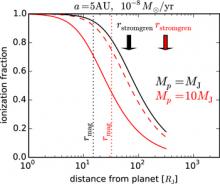
Abstract
When planet-hosting stars evolve off the main sequence and go through the red-giant branch, the stars become orders of magnitudes more luminous and at the same time lose mass at much higher rates than their main-sequence counterparts. Accordingly, planetary companions around them at orbital distances of a few AU, if they exist, will be heated up to the level of canonical hot Jupiters and also subjected to a dense stellar wind. Given that magnetized planets interacting with stellar winds emit radio waves, such "Red-Giant Hot Jupiters" (RGHJs) may also be candidate radio emitters. We estimate the spectral auroral radio intensity of RGHJs based on the empirical relation with the stellar wind as well as a proposed scaling for planetary magnetic fields. RGHJs might be intrinsically as bright as or brighter than canonical hot Jupiters, and about 100 times brighter than equivalent objects around main-sequence stars. We examine the capabilities of low-frequency radio observatories to detect this emission and find that the signal from a RGHJ may be detectable at distances up to a few hundred parsecs with the Square Kilometer Array.